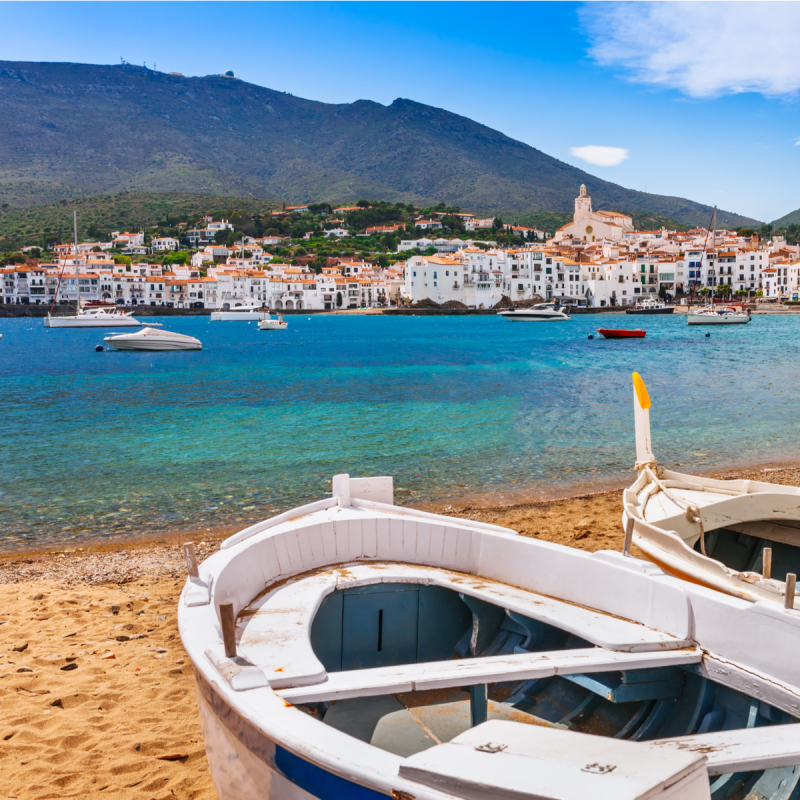
Costa Brava, which translates to “Wild Coast,” is the northeastern region of Catalonia that stretches from the French border all the way to Blanes not far from Girona and Barcelona. The coast is distinguished by a rugged landscape, deep coves, crystal blue seas, and long, white beaches and has, since the 1960s, been a very popular holiday destination for locals and foreign tourists alike.
Videos by TravelAwaits
It is a favorite destination and weekend escape for the citizens of Barcelona and Girona. Artists have also been attracted and inspired here, most famous among them, Salvador Dali. There is even a designated Dali Triangle, consisting of the villages of Cadaques, Figueres, and Pubol, all with houses, museums, and workshops used by the master.
To explore all the charming villages and small and not so small treasures these villages have to offer, you can go on a road trip, either from north to south or vice versa, and spend nights in a few of the cozy inns or hotels that dot the countryside. The roads are good, and you can easily find your way around.
1. Cadaqués
Cadaqués is one of the villages closest to France. Located on the Cap de Creus peninsula, here you have a chance to enjoy the stunning Cap de Creus National Park with cliffs falling steeply down to the sea but also quiet coves and sandy beaches.
At the head of the bay is the historic quarter where you can really feel the cultural and artistic vibe that characterizes the charming village. For decades, artists and painters have been inspired here and as a result, there are many museums and art galleries to admire. You can appreciate not only the house-museum of Dali that is close to Portlligat Bay, where he lived and worked for many years but also the works of famous artists like Picasso and Chagall who let their artistic juices flow here.
Cadaqués is also a great starting point to visit the Alt Empordaregio. Due to its proximity to France, it is very popular with French visitors and many locals speak French as well as Spanish and Catalan.
Pro Tip: If you visit in the winter be prepared for some very cold weather, brought on by the strong Tramuntana winds from the Pyrenees.
Whilst in the region, take the opportunity to sample some local specialties like suquet, a fish stew. and rice dishes. A special delight awaits in Emporda, the national park of which is partly marshland, and the home to stork colonies and their huge nests.

2. Figueres
Located a few miles inland on the Ampurdan plain with the Pyrenees towering in the background, Figueres is the largest town in northern Catalonia and the capital of Alt Empora. The town is best known for its association with Salvador Dalí, who was born there in 1904, and the distinctive red museum. It is a symbol of surrealism with the white egg-shaped balls on the roof and the tower that is part of a former theater that burned down, though the tower remains incorporated in the museum.
It may be the most distinctive landmark, but there are other things to see too; including Sant Ferran castle and the Catalan Toy Museum.
Figueres is very well connected by rail and motorways to the rest of Catalonia and even to the south of Spain.

3. Púbol
If you are a Dalí fan, you cannot miss a visit to the Gala Dalí Castle House in Púbol. This is a small, medieval village in the Baix Emporda part of La Perla/Girona, which already had a castle in very poor condition that Dali bought in 1996.
Gala was his wife and muse to whom he was devoted, and he had promised to make her the queen of a castle. So, he did. The interior is exquisitely decorated, of highly personal significance to the artist, and with a visit, you have completed the Dali Triangle.

4. Roses
Roses is a charming seaside town, located at the head of the Bay of Roses, on the northeastern coast of Spain, just a short drive from France. The town is most famous for its fabulous beaches and watersport activities, from the long stretch of sand toward Empuriabrava to smaller coves and beaches.
But, Roses, sometimes also called Rosas, is also a historical town. It flourished during the Middle Ages, when pirate attacks were frequent (even Barbarossa tried his luck) and strong fortifications had to be built. Witness to that is the 17th century Ciutadella de Roses, the castle of the Trinitat, and the castle of Guardiola.
Pro Tips: If you are interested in history, you can take a route through the castles of Roses. There is also a lighthouse and, as special entertainment, a lively Sunday market.

5. Girona
So far, we have told you about charming seaside villages on the Costa Brava, but one cannot leave out a visit to Girona. Located inland, halfway between Barcelona and the coast, Girona is a larger city that also has an airport.
Game of Thrones fans will be delighted to discover many locations where scenes were filmed, especially on the steps of the cathedral. The River Onyar runs through the city. Don’t miss the chance to cross the distinctive, red bridge that was built by none other than Mr. Eiffel.
Other highlights are a walk along the massive medieval walls or a stroll through one of Europe’s best-preserved Jewish quarters.
If you happen to visit in the second week of May, you are in for a treat. It’s the time of the famous Girona Flower Festival, when all the streets and pavements are covered with a carpet of thousands of fresh flowers, an absolute delight for the senses.

6. Begur
Begur is located in the heart of the Emporda and made up of several hills. Defense towers and colonial houses make for an interesting, cultural experience. But, the greatest attraction of one of the Costa Brava’s most beautiful seaside resorts are the coves, flooded with crystal clear water and a preferred destination for snorkelers and scuba divers.
There are no less than eight beaches here. If you want a secluded beach without luxuries, Platja d’EnMalaret is for you. Platja Fornells has a marina and a path that gives access to many coves. For a great view over the countryside, climb up to the castle or to the viewpoint called Mirador de la Creu.

7. Tossa De Mar
Tossa de Mar is located in the southernmost part of the Costa Brava and, because of its proximity to Barcelona, is a favorite day trip or weekend destination for the locals. It is a lovely, small village with winding, cobbled streets, quirky boutiques, and arts and crafts shops, which are well stocked because the enticing landscape has inspired many artists. Surrounded by lush, green vegetation, any walk or hike in Tossa de Mar is a joy.
The Costa Brava really justifies its name in Tossa de Mar because of the dazzling Cala Levado Trail. The path closely follows the cliffs of the coastline with many ups and downs and ends at the old medieval castle, a rather big complex with many cafes and restaurants inside. Platja Gran (big beach) is the largest of the many beaches that follow the coastline, all of them with fine, white sand. Tossa de Mar is a good opportunity to sample the excellent local seafood, preferably paella, the Spanish rice and seafood dish. One of the best restaurants is Can Pini with excellent paella, friendly service, and a pretty, rustic atmosphere.
Pro Tip: Paella is a dish that is shared among at least two people. No single portions are served. The best part is the crust that is scraped from the bottom of the pan.

8. Blanes
Depending on where you stand, Blanes is the beginning or the end of the Costa Brava. It is often considered the ultimate Costa Brava destination and has all the great features that the other charming villages have, like coves, rugged coastlines, a sin fin of beaches, and water sports. But Blanes has one or two little extras — it is a garden town full of flowers with not one but two botanical gardens: a botanical garden, called Marimurta, and a tropical garden. And then there is a combined zoo and waterpark, Marineland. Scuba divers can plunge to their heart’s content off the rocks of Platja de Santa Anna and everybody else can sunbathe and swim at the long S’Abanell Beach.

9. Lloret De Mar
Also on the southern end of the Costa Brava lies the popular beach resort of Lloret de Mar. Like in Blanes, there is an abundance of flowers growing in Lloret de Mar to be admired in the Santa Clotilde Gardens.
Another great attraction is the Santa Roma church, the modernist cemetery, and the Maritime Museum. For history lovers, there is the Castel de San Joan to explore, and for beach lovers the Playa de Fenals to lounge on.
Finally, there are some super interesting Roman ruins to visit: the 2,300-year-old ruins of Puig de Castellet, built by the first people who ever lived in Lloret de Mar and undiscovered until 1943.
If you like eye-catching architecture and stunning photo opportunities, head to the historical Villa Xardo and feed your Instagram account.
For more Spanish inspiration, consider
